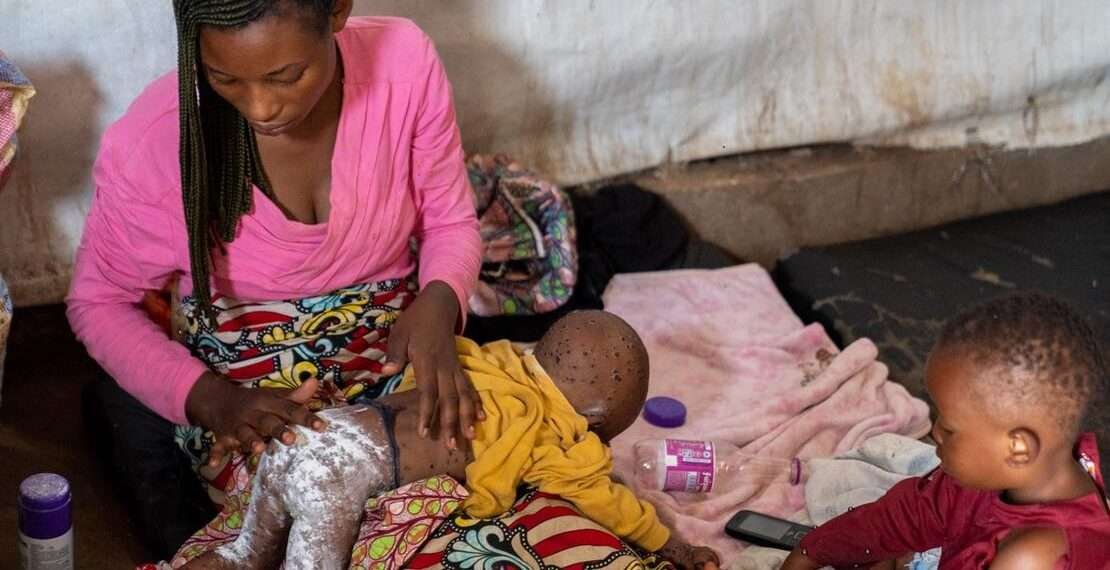In the Munigi Health Center, in Nyiragongo territory of the Democratic Republic of Congo (DRC), the battle against mpox is in full force. The urgency is unmistakable as medical staff work tirelessly within makeshift tents to treat confirmed cases and curb the spread of this deadly virus.
Since mid-June, the Munigi Health Center, located in the eastern part of the DRC, has reported 281 suspected cases of mpox, with 75% of these cases involving children under the age of 10.
In North Kivu province alone, authorities have recorded over 500 cases, underscoring the severity of the outbreak.
One such patient is Nyota Aziza, who is currently receiving treatment at Munigi. “I had a fever and a bad headache,” she recalls. “My relatives told me it was smallpox. I was brought here, and the doctors have been taking care of me every step of the way.”
New Patients Surge Daily
In Nyiragongo General Hospital, where a dedicated site has been set up by the Medair organization, nearly ten new patients arrive daily, showing the same troubling symptoms.
Medair’s priority is to protect the most vulnerable, but the situation remains deeply concerning, according to nurse Tresor Basubi.
“Every day, we receive nine patients with the same mpox symptoms,” Basubi explains. He further adds that, for now, there is no specific treatment. “We treat patients based on the symptoms they present, following the national protocol.”- Tresor Basubi
The outbreak has hit the DRC particularly hard. Ngashi Ngongo, chief of staff for the Africa Center for Disease Control and Prevention (Africa CDC) in Kinshasa, highlighted the collaborative efforts of NGOs and African governments in mobilizing the population to tackle the virus.
“All the countries have either developed or updated their outbreak response plans, which is very positive,” Ngongo noted.
He mentioned that significant meetings between stakeholders and the government, including the minister of finance and the prime minister of the DRC, have taken place. “This is a big change, a really big boost. The government is really waking up,” Ngongo said.
Mpox Outbreak Hits Children the Hardest
The mpox outbreak has dealt a devastating blow to the DRC. According to Africa CDC, the Central African nation has reported at least 17,342 suspected cases, with 3,167 of those cases confirmed through laboratory testing. Tragically, the virus has claimed 582 lives so far.
Ngongo elaborated on why children are particularly vulnerable to the virus. “The high infection rates among children can be attributed to the intensity of their contacts and the fact that their immune systems are still developing,” he explained.
Alarmingly, nearly 40% of the children in the DRC suffer from chronic malnutrition, a condition that could exacerbate the spread of the virus as schools reopen.
Ngongo expressed deep concern about this potential increase in infection rates, as children return to classrooms and come into close contact with one another.

Stressing the Importance of Hygiene
The situation is particularly dire in camps for internally displaced people (IDPs) in eastern DRC, where the spread of mpox has been severe. Health workers are now focusing on raising awareness about the disease, teaching people about its symptoms, where to seek help, and how to protect themselves.
Their primary message is simple but crucial: follow hygiene rules. In a region where approximately 750,000 people are living in IDP camps after fleeing conflict, more than 100 children have already been infected with mpox.
“We’ve been educating people about mpox, explaining how to prevent it and stressing that it’s a very dangerous disease,” said Furaha Bineyo, a displaced person. “It’s a disease transmitted through bodily contact, so we need to be very strict about hygiene, like washing hands regularly.”- Furaha Bineyo.
Despite the challenges, there is a glimmer of hope. Pierre Olivier Ngadjole, Medair DRC’s health advisor, remains optimistic. “The good news is that with the communication we’ve started in the camps, people are coming early for treatment, and we have an estimated cure rate of over 90%, with no deaths to date.”
READ ALSO: GCB Bank Demonstrates Robust Growth with Impressive 1H 2024 Financial Performance























